Hello, everyone! I'm so excited to share my Adobo Burrito recipe with you today. This is honestly one of my favorite ways to transform leftover adobo into something completely new and exciting. I came up with this idea one day when I had some adobo in the fridge and wanted something different for lunch.
By combining our beloved Filipino adobo with the convenience of a Mexican-style burrito, I created a portable meal that's perfect for busy days, picnics, or packed lunches. The savory adobo meat, flavorful rice, and tangy salted egg salsa wrapped in a soft tortilla create an incredible flavor combination that my family now requests regularly.
It's so simple to make yet feels special, and I love that it reduces food waste by giving leftovers a delicious makeover. Once you try these burritos, you'll be making extra adobo just for this purpose.
What Is An Adobo Burrito?
An Adobo Burrito is a delicious fusion dish that combines Filipino and Mexican culinary traditions. Traditional Filipino adobo—a savory stew of meat marinated and cooked in a flavorful mixture of soy sauce, vinegar, black peppercorns, garlic, and bay leaves—is shredded and used as the main filling for a flour tortilla wrap.
The burrito format transforms this classic Filipino dish into a portable, all-in-one meal that includes rice and a fresh salted egg salsa. It's perfect for those who love to experiment with global flavors and is an excellent way to repurpose leftover adobo into an exciting new meal.
Jump to:
Why You'll Love This Recipe
You'll fall in love with this Adobo Burrito recipe because it brilliantly transforms leftover adobo into something new and exciting! This fusion dish combines the beloved Filipino adobo with Mexican-inspired burrito wraps, creating a portable meal that's perfect for lunch boxes, picnics, or quick dinners.
The combination of savory adobo, flavorful rice, and tangy salted egg salsa creates a perfect balance of flavors in every bite. Plus, it's an excellent way to reduce food waste by repurposing leftovers into a completely new dish your family will request again and again.
Ingredients
I carefully selected these ingredients to create the perfect balance of flavors in my Adobo Burrito. The shredded adobo meat brings that classic Filipino savory taste with hints of soy sauce and vinegar, while the adobo-infused rice adds texture and absorbs all those delicious flavors.
The salted egg salsa provides a bright, tangy contrast that cuts through the richness of the meat and rice, with fresh tomatoes, onions, and cilantro adding freshness. I chose to include ginger for that subtle warmth and zing that complements the adobo perfectly. The large flour tortillas bring everything together in a convenient wrapper that holds up well without getting soggy.
These ingredients create a satisfying fusion meal that respects the original adobo flavors while transforming them into something exciting and portable.
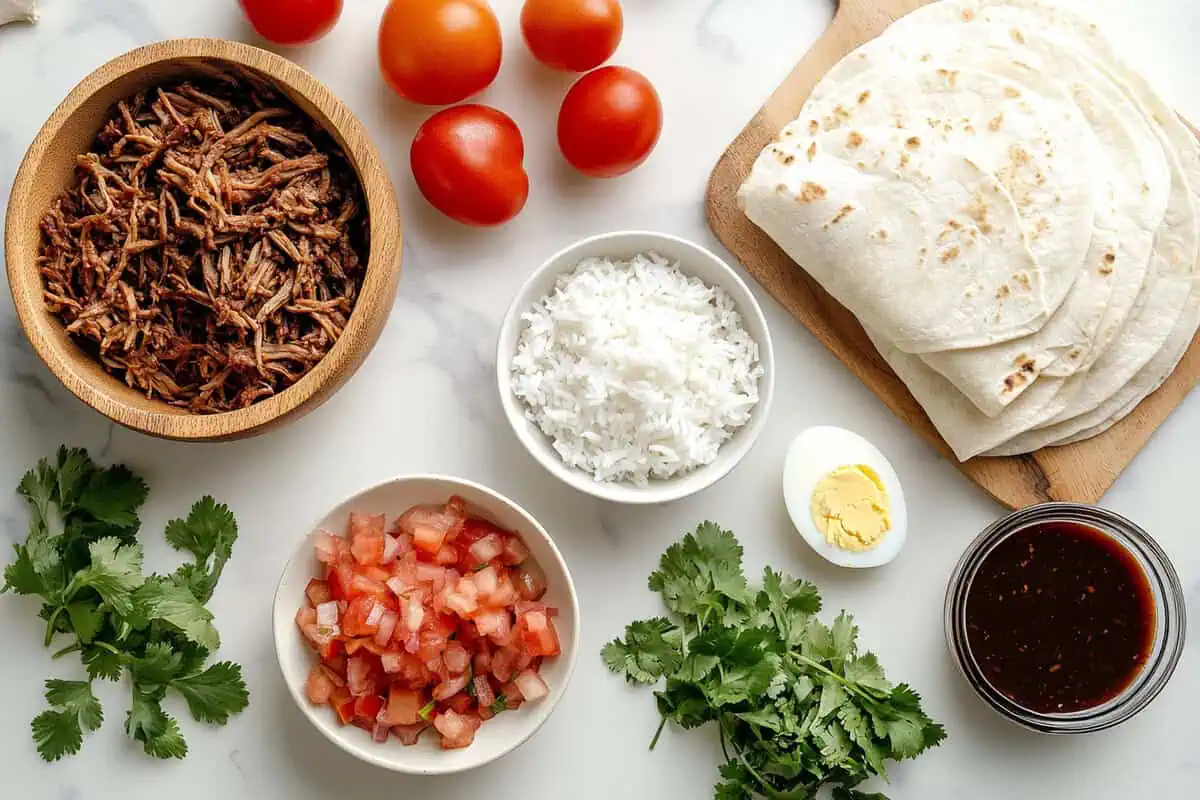
- 1 tablespoon chopped garlic
- 3 cups cooked rice
- ½ cup leftover adobo sauce
- 4 large flour tortillas, heated on a dry pan
- 1 cup shredded adobo flakes (from leftover adobo)
- 1 piece salted egg (itlog na maalat), finely chopped
- ½ cup chopped tomatoes
- ¼ cup chopped onion
- 1 tablespoon chopped cilantro (wansoy)
- 2 tablespoons finely chopped ginger
Equipment
- Skillet or frying pan
- Cutting board and knife
- Mixing bowls
- Spatula or wooden spoon
- Aluminum foil or parchment paper for wrapping
- Optional: Mini food chopper for salsa ingredients
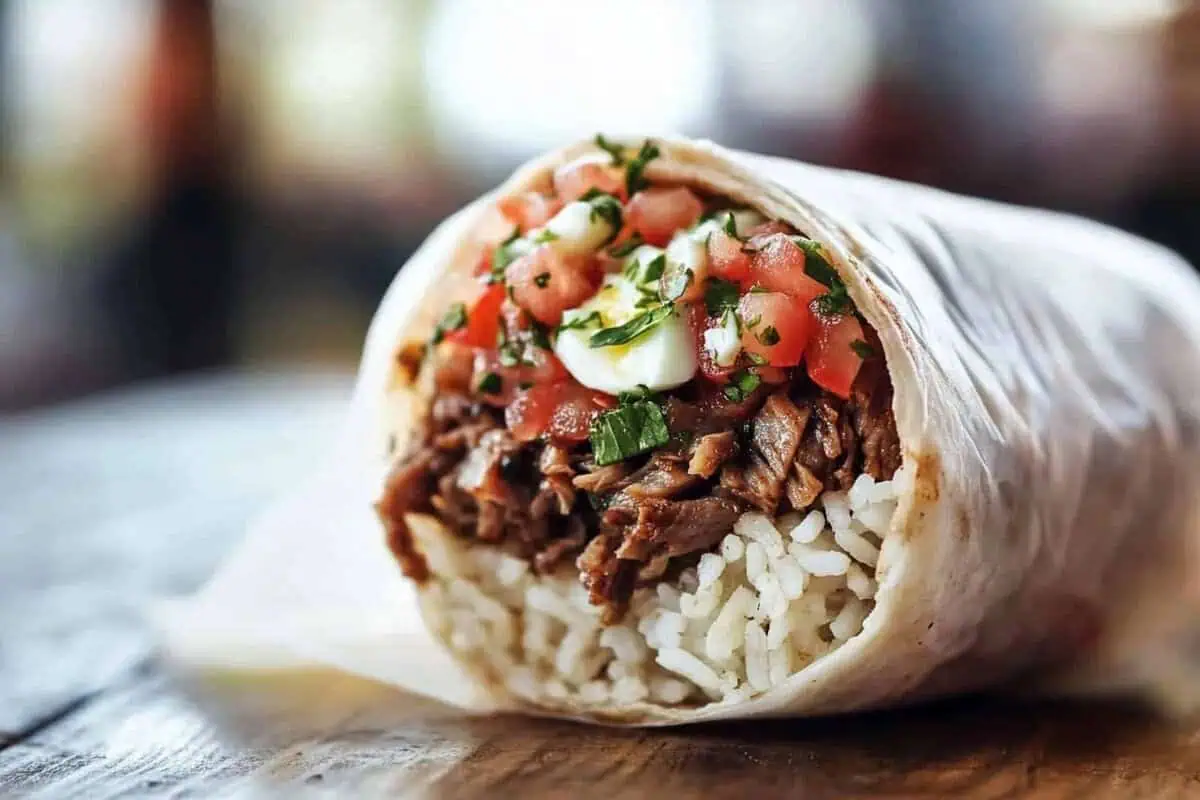
How To Make
- Prepare the adobo rice: In a skillet, sauté the chopped garlic until fragrant. Add the cooked rice and leftover adobo sauce. Mix well until the rice is evenly coated with the sauce. Set aside.
- Make the salted egg salsa: In a bowl, combine the chopped salted egg, tomatoes, onion, cilantro, and ginger. Mix well and set aside.
- Assemble the burritos: Place a heated flour tortilla on a flat surface. Layer with ½ cup of the prepared adobo rice, 3 tablespoons of shredded adobo flakes, and 2 tablespoons of the salted egg salsa.
- Wrap the burritos: Roll up the tortilla, tucking in the ends as you go. Wrap tightly in aluminum foil or parchment paper to secure.
- Serve: Place in a hotbox or insulated container until ready to serve, or enjoy immediately.

Tips from Lola's Kitchen
- Make your adobo in bulk: Prepare a large batch of adobo and freeze portions for future meals, including these burritos.
- Perfect rice texture: For the best burrito experience, use day-old rice that's been refrigerated as it holds together better in the wrapping.
- Toasting your tortillas: Quickly heat your flour tortillas on a dry pan before assembling—this makes them more pliable and less likely to tear during wrapping.
- Wrapping technique: Place your filling slightly off-center (toward you) on the tortilla for easier wrapping, and don't overfill or your burrito may burst.
- Serve with extra salsa: The salted egg salsa adds a wonderful contrast to the savory adobo—make extra to serve on the side!
Substitutions
- Meat options: While traditional adobo uses pork or chicken, you can use beef, tofu, or mushroom adobo for variety.
- Rice alternatives: Brown rice or cauliflower rice can be substituted for white rice for a healthier option.
- No salted egg? Use feta cheese mixed with a bit of salt as a substitute, or try regular boiled eggs with extra salt.
- Cilantro substitute: If you're not a fan of cilantro, use fresh parsley or mint instead.
- Tortilla options: Whole wheat, spinach, or tomato-flavored tortillas can add extra flavor and nutrition.
Troubleshooting
- Burrito falling apart? You might be overfilling it. Use less filling or larger tortillas, and make sure to tuck in the sides firmly before rolling.
- Too dry? Add a bit more adobo sauce to the rice or include some sour cream in your filling.
- Too wet? Let your adobo drain excess sauce before shredding, or use less sauce in your rice mixture.
- Tortilla tearing? Make sure to warm your tortillas before wrapping—cold tortillas are more likely to tear.
Storage & Reheating
- Refrigeration: These burritos can be made ahead and refrigerated for up to 2 days. Wrap tightly in foil or parchment paper, then place in an airtight container.
- Avoid freezing: While the adobo itself can be frozen, complete burritos with rice and tortillas are best not frozen as the texture may become soggy when thawed.
- Reheating: To reheat, remove the foil and warm in a microwave for 1-2 minutes, or place the foil-wrapped burrito in a 350°F oven for 10-15 minutes until heated through.
- Lunchbox tip: These burritos can be packed in lunchboxes in the morning. By lunchtime, they'll have thawed to a perfect temperature for eating.
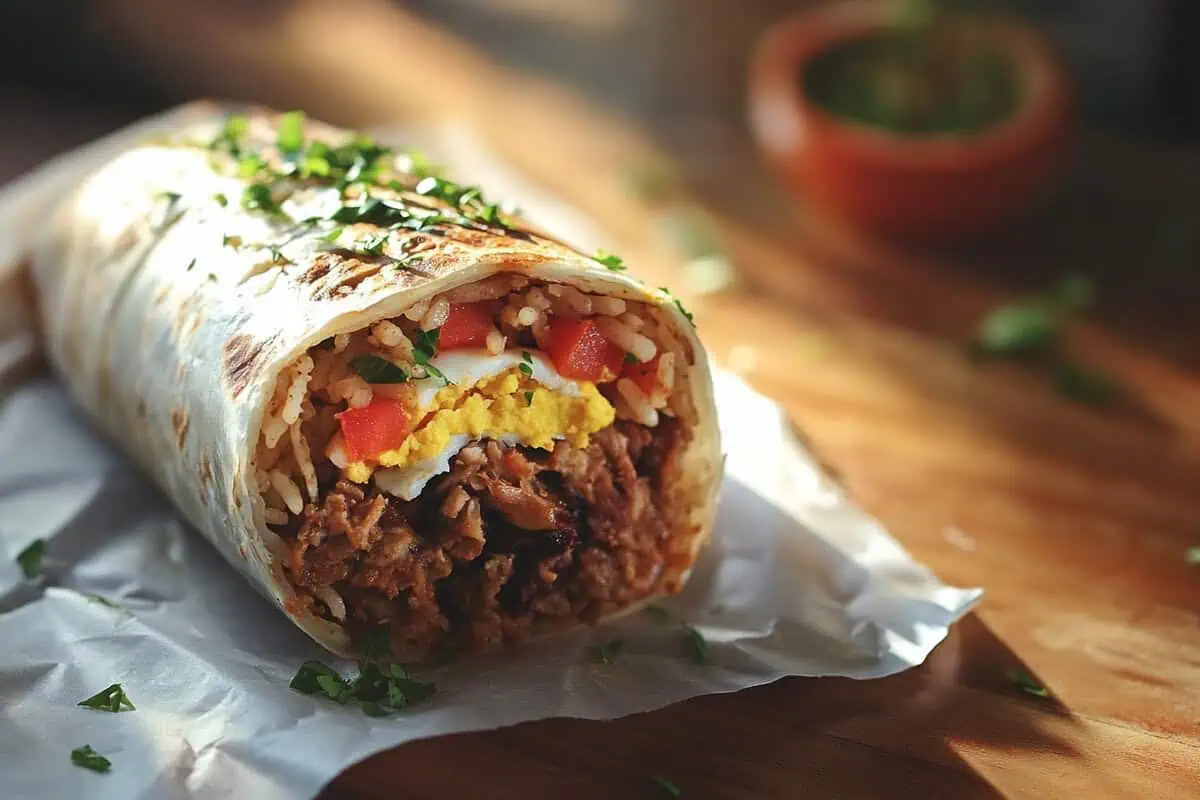
FAQ
Can I make this with fresh adobo instead of leftovers?
Absolutely! Simply cook your preferred adobo recipe, shred the meat, and continue with the burrito assembly.
How can I make these burritos spicier?
Add chopped jalapeños or hot sauce to your salted egg salsa, or include some chili flakes in your adobo rice mixture.
Can I make mini versions for appetizers?
Yes! Use small flour tortillas or cut larger ones in half to create bite-sized versions perfect for parties and gatherings.
How can I keep my burrito from getting soggy if packing for lunch?
Make sure your adobo filling isn't too wet, and wrap the burrito tightly in parchment paper, then foil. This double wrapping helps keep moisture in check.
What can I serve with these burritos?
While they're complete meals on their own, they pair wonderfully with a side of extra salted egg salsa, a simple green salad, or crispy plantain chips.
Related
Looking for other recipes like this? Try these:

Adobo Burrito Recipe
Ingredients
- 1 tablespoon chopped garlic
- 3 cups cooked rice
- ½ cup leftover adobo sauce
- 4 large flour tortillas heated on a dry pan
- 1 cup shredded adobo flakes from leftover adobo
- 1 piece salted egg itlog na maalat, finely chopped
- ½ cup chopped tomatoes
- ¼ cup chopped onion
- 1 tablespoon chopped cilantro wansoy
- 2 tablespoons finely chopped ginger
Instructions
- Prepare the adobo rice: In a skillet, sauté the chopped garlic until fragrant. Add the cooked rice and leftover adobo sauce. Mix well until the rice is evenly coated with the sauce. Set aside.
- Make the salted egg salsa: In a bowl, combine the chopped salted egg, tomatoes, onion, cilantro, and ginger. Mix well and set aside.
- Assemble the burritos: Place a heated flour tortilla on a flat surface. Layer with ½ cup of the prepared adobo rice, 3 tablespoons of shredded adobo flakes, and 2 tablespoons of the salted egg salsa.
- Wrap the burritos: Roll up the tortilla, tucking in the ends as you go. Wrap tightly in aluminum foil or parchment paper to secure.
- Serve: Place in a hotbox or insulated container until ready to serve, or enjoy immediately.
Tips from Lola's Kitchen
- Make your adobo in bulk: Prepare a large batch of adobo and freeze portions for future meals, including these burritos.
- Perfect rice texture: For the best burrito experience, use day-old rice that's been refrigerated as it holds together better in the wrapping.
- Toasting your tortillas: Quickly heat your flour tortillas on a dry pan before assembling—this makes them more pliable and less likely to tear during wrapping.
- Wrapping technique: Place your filling slightly off-center (toward you) on the tortilla for easier wrapping, and don't overfill or your burrito may burst.
- Serve with extra salsa: The salted egg salsa adds a wonderful contrast to the savory adobo—make extra to serve on the side!
The Story Behind Adobo Burritos
Adobo Burritos represent the beautiful evolution of Filipino cuisine in a modern, global kitchen. This dish perfectly showcases how traditional recipes can transform into exciting new creations while honoring their cultural roots.
Filipino adobo has ancient origins dating back centuries, with its vinegar-based preservation method existing long before Spanish colonizers arrived in the Philippines. The name "adobo" came from the Spanish word "adobar," meaning to marinate, but the cooking technique was already deeply ingrained in Filipino culture. Today, adobo is widely recognized as the unofficial national dish of the Philippines, with countless regional and family variations across the archipelago.
What makes adobo so special is its perfect balance of salty, tangy, and savory flavors. The essential combination of vinegar, soy sauce (or salt in pre-colonial versions), garlic, bay leaves, and black pepper creates a dish that's not only delicious but also preserved well in tropical climates before refrigeration became common. Traditionally, adobo was cooked until the meat was tender and the sauce reduced, making it ideal for keeping for several days—which is why Filipino families often make large batches.
This practical aspect of adobo—its ability to taste even better as leftovers—is what inspired this fusion creation. Burritos, originally from northern Mexico, serve a similar purpose in Mexican cuisine: creating a portable, complete meal wrapped in a flour tortilla. The burrito concept dates back several centuries, with modern versions becoming popular in the United States during the 20th century.
The Adobo Burrito represents the natural marriage of Filipino and Mexican culinary traditions, both shaped by Spanish colonial influence yet distinctly their own. This fusion makes perfect sense when you consider the historical connections—the Manila-Acapulco Galleon Trade route connected the Philippines and Mexico for 250 years during Spanish colonial rule, leading to significant cultural exchanges that are still evident today.
What makes this recipe particularly special is how it transforms traditional adobo into something new while reducing food waste. The Filipino value of resourcefulness shines through in repurposing leftover adobo into an exciting new dish. The addition of the salted egg salsa introduces another Filipino favorite—itlog na maalat (salted duck egg), bringing a unique twist that distinguishes this fusion dish from standard burritos.
Home cooks across the Philippines have embraced this kind of culinary creativity, especially in recent years as global cuisines become more accessible. The Adobo Burrito represents the innovative spirit of modern Filipino cooking—honoring traditions while embracing new ideas and influences. It's the perfect example of how comfort food can evolve across cultural boundaries while remaining true to its delicious origins.
Whether you're making these burritos for a quick weekday lunch, a picnic with friends, or introducing someone to Filipino flavors in an approachable way, this dish carries with it the rich history and warm hospitality that Filipino cuisine is known for. Each bite tells a story of cultural exchange, resourcefulness, and the universal joy of transforming simple ingredients into something extraordinary.
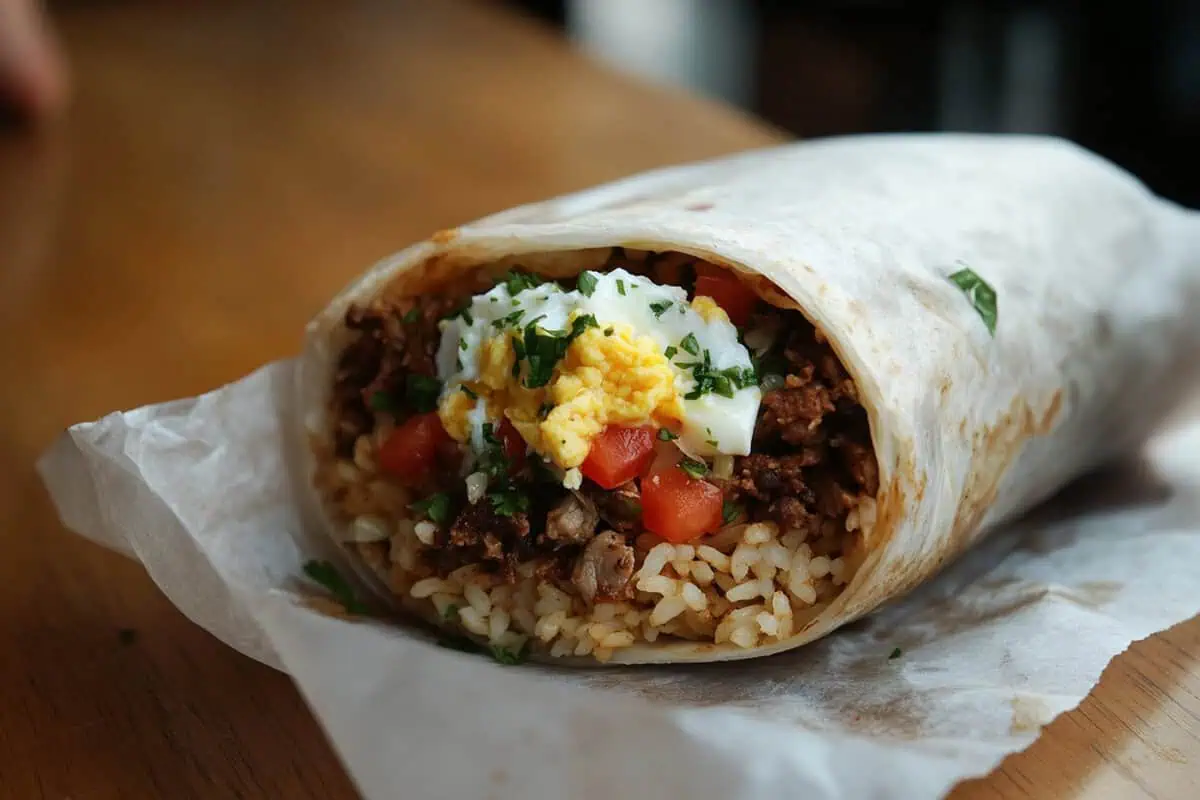







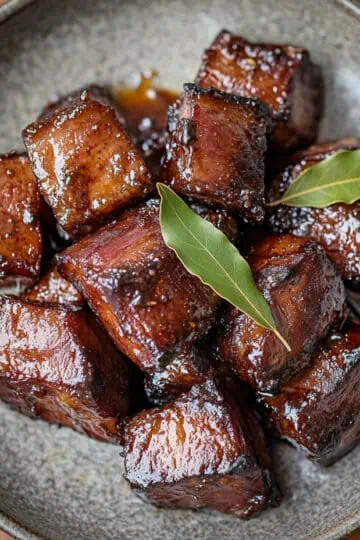

Comments
No Comments